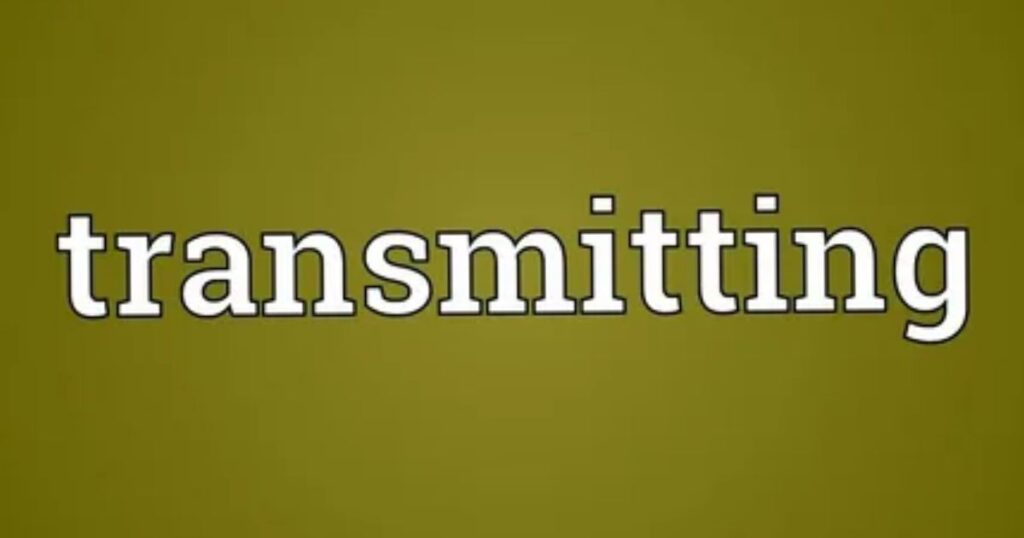Every second, countless pieces of information travel around the world. This magic is called transmitting , the powerful process that moves messages from one place to another. Whether you’re chatting with a friend, sending an email, or sharing a photo, transmitting keeps us connected. It makes sure your words and ideas reach others quickly and clearly. Without transmitting, staying in touch or sharing knowledge would be almost impossible.
Today, transmitting uses amazing tools like Wi-Fi, Bluetooth, and digital platforms to boost communication. It’s not just about sending messages , it’s about forwarding, relaying, and transferring data seamlessly. When done right, transmitting ensures message accuracy and avoids confusion. It keeps the flow of information smooth, helping ideas spread fast and clear across the globe.
- Sharing facilitates smooth transmission of information across digital platforms, supporting collaboration, knowledge sharing, and connection building.
- Disseminating systematically distributes information to wide audiences, ensuring timely delivery and maintaining message accuracy and clarity.
- Forwarding enables the efficient redirection of messages or data, playing a vital role in keeping communication timely and accurate.
- Conveying focuses on clearly expressing ideas and emotions, using verbal and non-verbal cues to maintain message integrity during transmission.
- Transmitting is the core of all communication, involving electronic transfer, broadcasting, and various communication tools to ensure reliable information flow.
- Maintaining signal clarity and minimizing message distortion are essential to effective transmitting, ensuring communication accuracy across different channels.
- Effective transmission empowers freedom of expression, collaboration, innovation, and informed decision-making within diverse communication environments.
Sending is one of the most fundamental methods of transmitting information. Whether you send an email, a message, or a physical package, the process involves moving data or items from one point to another. With advances in digital platforms, sending information has become quicker and more accessible, empowering users to connect effortlessly across distances.
When transmitting information through sending, clarity in communication is vital. The use of communication tools like email and messaging apps ensures that messages reach their intended audience with accuracy. Miscommunication can occur if message distortion happens during the sending process, so maintaining message accuracy is essential.
The environment in which sending occurs also impacts communication effectiveness. For example, postal services handle physical sending, while digital platforms facilitate electronic transfer and data migration. Both methods play key roles in the broader communication landscape, making sending an indispensable part of transmitting information today.
Conveying information is about more than just sending, it’s the art of transmitting ideas, emotions, and facts clearly to your audience. When you convey a message, you focus on clarity and transparency to ensure the receiver fully understands the intended meaning. Effective conveying relies on communication skills, both verbal and non-verbal, to enhance message delivery.
Transmitting through conveying also involves using various communication channels such as written communication, spoken words, or even visual aids. These methods help bridge the gap between sender and receiver, ensuring that information flow remains smooth and free from message distortion. Conveying emotions alongside facts further strengthens connections and builds trust.
In today’s digital age, conveying also includes collaborative sharing and digital sharing, where multiple individuals exchange ideas and knowledge seamlessly. This approach fosters innovation and collaboration, empowering teams and communities to make informed decisions through transparent communication.

Communicating is a broader concept that encompasses all forms of transmitting information, whether through sending, conveying, or relaying. It involves the interaction between people or systems using communication tools and methods that facilitate message accuracy and clarity. Effective communication boosts collaboration and understanding in any setting.
Wireless communication technologies like Wi-Fi and Bluetooth have revolutionized how we communicate, enabling real-time data transfer and message delivery without physical constraints. These advances have reshaped the communication landscape, making transmitting faster, more reliable, and more accessible than ever before.
To master communicating, one must consider the audience perspective, tailoring messages to suit different communication platforms and channels. By doing so, you create a communication environment where freedom of expression thrives, and the exchange of information is continuous, fostering an informed and engaged community.
Relaying is a specialized form of transmitting that focuses on forwarding messages accurately from one party to another. It requires maintaining signal clarity and preventing message distortion during transmission. In many communication systems, relaying acts as a bridge, ensuring information reaches its destination intact.
This method plays a critical role in emergency services communication and corporate communication, where timely delivery of information can impact lives and business decisions. The systematic information distribution involved in relaying contributes to communication effectiveness by minimizing delays and errors in message redirection.
Additionally, relaying supports network communication by enabling data forwarding and email forwarding across devices and systems. These processes ensure smooth information flow, improving data accessibility and supporting collaboration in both personal and professional contexts.
Dispatching involves transmitting information through the organized and timely delivery of messages. This communication method is essential in sectors like emergency services communication, where dispatching clear and accurate instructions can save lives. It also plays a key role in corporate communication for managing workflows efficiently.
Effective dispatching relies on communication tools and platforms designed to support rapid message delivery and reduce the risk of message distortion. Digital platforms have enhanced dispatching by enabling electronic transfer of critical data, ensuring communication accuracy and fostering transparency.
By incorporating systematic information distribution, dispatching strengthens the communication process and empowers organizations to respond quickly and effectively. This enhances overall communication clarity and helps build connections through transparent communication channels.
Transferring information is a vital aspect of transmitting, involving the movement of data between systems or individuals. Electronic transfer and data migration are common methods that enable organizations to keep information accessible and well-organized. Proper transferring ensures data integrity and supports informed decision-making.
Whether transferring files via network communication or sending data through wireless communication technologies like Wi-Fi and Bluetooth, maintaining message accuracy is crucial. Missteps during transfer can cause message distortion, disrupting the communication flow and impacting information accessibility.
In a rapidly evolving communication landscape, transferring facilitates continuous data exchange, supporting knowledge sharing and idea exchange across various platforms. The ability to transfer information seamlessly empowers individuals and organizations to innovate and collaborate effectively.
Read More: 14 Other Ways to Say “Transmit”
Broadcasting stands out as a powerful way of transmitting information to a wide audience simultaneously. Using radio waves and digital signals, broadcasting delivers news, entertainment, and educational content across vast distances, making it an essential tool for mass communication.
The beauty of broadcasting lies in its ability to reach diverse groups, fostering a shared experience and promoting information dissemination on a large scale. Advances in communication technology continue to enhance broadcasting’s reach, expanding access to important messages through various communication channels.
By utilizing broadcasting effectively, communicators can promote freedom of expression and ensure message spread is both timely and accurate. This contributes to a more informed public and supports ongoing collaboration and innovation within society.
Sharing plays a crucial role in transmitting information across various communication platforms. Whether through digital sharing or collaborative sharing, it ensures that data and ideas flow smoothly between individuals and groups. By sharing content like news, entertainment, or educational material, people build connections and enhance information accessibility.
When transmitting via sharing, communication tools such as emails, messaging apps, and social media come into play. These tools help maintain message accuracy and signal clarity, reducing the risk of message distortion. Effective sharing creates an environment where knowledge sharing and idea exchange thrive, leading to better collaboration and innovation.
Sharing also supports freedom of expression by giving audiences the ability to receive and contribute information seamlessly. As part of the broader communication landscape, sharing empowers users to participate actively in conversations, promoting transparency and informed decision-making in both personal and corporate communication.
Disseminating involves transmitting information systematically and efficiently to a broad audience. This process is essential for distributing news, educational content, and emergency updates where timely delivery can have significant impact. Using digital platforms and communication channels, disseminating ensures message spread is fast and reliable.
In transmitting through dissemination, maintaining communication clarity and message accuracy is vital. Signal clarity prevents information loss or distortion, allowing recipients to fully grasp the intended message. Disseminating information using electronic transfer methods, such as email forwarding or data forwarding, supports smooth communication across networks.
Furthermore, disseminating contributes to the information flow in society by making knowledge accessible to diverse groups. It fosters collaboration and connection building by promoting transparent communication, which empowers communities and organizations to respond effectively to changing needs and opportunities.
Forwarding is a key technique in transmitting messages from one point to another, often used in both personal and corporate communication. This method involves data forwarding, email forwarding, or message redirection to ensure that information reaches the right people promptly and clearly.
Transmitting via forwarding demands attention to message accuracy and communication effectiveness. Without careful handling, message distortion or signal issues can disrupt the information transfer. By utilizing robust communication tools and methods, forwarding strengthens communication clarity and supports seamless data exchange.
Moreover, forwarding fits within the broader communication process as an essential mechanism for maintaining the information flow. It enhances communication platforms by enabling timely delivery and contributing to communication empowerment, allowing for efficient collaboration and informed decision-making.
Conveying is about more than just transmitting words; it involves expressing ideas and emotions with clarity and purpose. Effective conveying uses verbal and non-verbal cues to ensure messages are understood and felt by the audience, which is crucial in maintaining message accuracy during transmission.
When transmitting through conveying, communication channels like written communication, face-to-face interaction, and digital sharing help amplify the message. Using communication tools and methods thoughtfully enhances communication clarity, preventing message distortion and fostering transparent communication environments.
Conveying also supports collaboration and knowledge sharing by allowing ideas to flow freely. This open exchange of information empowers individuals and organizations to innovate, connect, and make well-informed decisions within a dynamic communication landscape.

Transmitting forms the backbone of all communication processes, encompassing sending, sharing, conveying, and forwarding information. It involves the electronic transfer of data, broadcasting signals, and even physical methods like postal services to ensure information reaches its destination accurately and on time.
Effective transmitting requires maintaining signal clarity and minimizing message distortion to preserve communication accuracy. Whether through wireless communication technologies such as Wi-Fi and Bluetooth or traditional communication platforms, the goal remains the same: smooth, reliable information transfer.
By mastering transmitting techniques, communicators enhance the communication environment, supporting freedom of expression and connection building. This foundation promotes transparency and empowers audiences, making information flow and collaboration natural parts of everyday communication.
In conclusion, transmitting is a vital part of how we share and send information every day. It helps keep messages clear and accurate. Without transmitting, ideas and knowledge would not flow smoothly. We rely on transmitting through many communication tools and channels like Wi-Fi, emails, and digital platforms. This makes sure messages reach the right audience quickly and without distortion.
Good transmitting also supports collaboration, sharing, and forwarding information easily. It improves communication effectiveness and message delivery. Whether it’s through electronic transfer, data migration, or wireless communication, transmitting keeps us connected. Understanding transmitting helps us value the role of communication methods and tools. It ensures information accessibility and clarity. Overall, transmitting shapes how we exchange ideas and express emotions in today’s fast communication landscape.

Grammarbeam is a smart language assistant built for clarity, creativity, and precision. From polishing grammar to exploring rich synonyms and refining sentence structure, Grammarbeam is your go-to tool for powerful communication. If you’re writing for school, business, or just for fun — let your words shine with Grammarbeam.

